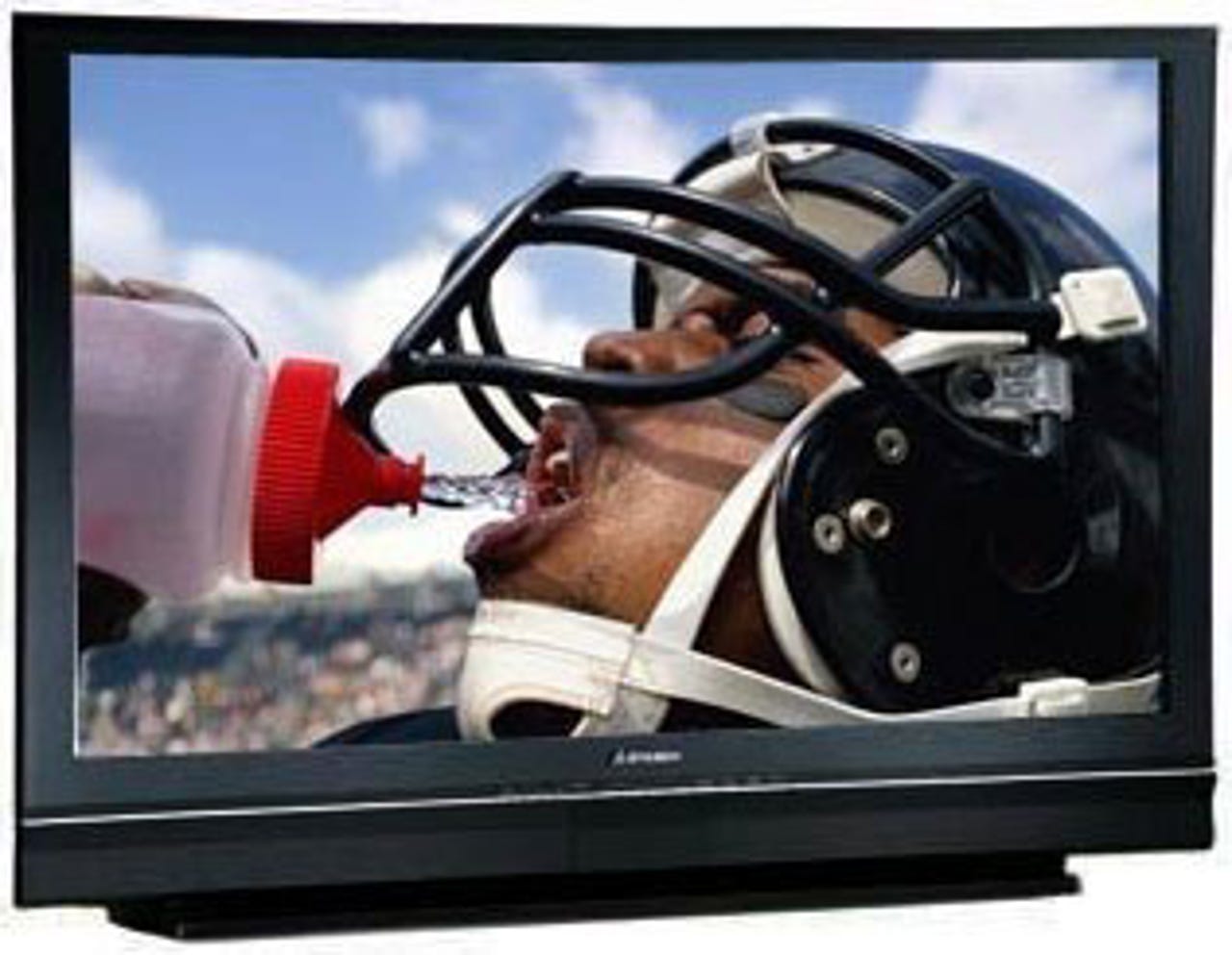Photos: For TVs, big and flat is where it's at

103-inch Panasonic
The last year has seen offerings from many of the major electronics manufacturers, ranging from a relatively puny 47 incher to the current giant of the bunch, which tops 100 inches. Here is a collection of just some of the whoppers that have been announced this year.
The world's biggest producer of plasma TVs is planning to sell the world's largest plasma TV by early 2007, according to Reuters and other sources.
Matsushita Electric Industrial announced Monday that it hopes to sell a 103-inch plasma TV, beating out Samsung's announced 102-inch plasma screen by exactly an inch. The flat panel, which was shown off at the Consumer Electronics Show in January, is described as "bigger than a double-sized mattress and almost as heavy as an upright piano." The high-definition television measures about 7.8 feet by 4.5 feet and weighs a mammoth 474 pounds.
100- and 102-inchers
Among many cutting-edge display types were a few monster TVs. The title for who makes the biggest flat-screen TV changes hands quickly, and the major players continue to outdo each other, often one inch at a time.
On the left, a 100-inch diagonal LCD TV from LG.Philips. "The dream of a 100-inch LCD screen is now a reality," said Bock Kwan, chief marketing and sales officer at LG.Philips. Right: down the hall, archrival Samsung shows off a 102-inch plasma.
Manufacturers disagree on whether LCDs or plasma technology will emerge victorious as TVs continue to grow. Panasonic, for one, has its money on plasma.
Yoshi Yamada, CEO of Panasonic North America says the future of large TVs is in plasma. That's because plasma provides a superior viewing experience over LCD in televisions with screens measuring 40 inches or more, Yamada said. Large plasmas also remain cheaper to make. Plus, making a plasma TV only requires two days, he said, while popping out a similar LCD takes seven days.
"There is no comparison. This is an inherent weakness of LCD," he said.
82-inch Samsung
Samsung launched an 82-inch LCD panel in Seoul on March 6. The South Korean company says the product is the world's largest full high-definition LCD television screen. Mass production is still at least 18 months away; no pricing was given.
67-inch Samsung HL-R6768W
The good: Excellent color accuracy after calibration; superb black-level performance; generous connectivity, including 1080p-capable computer input; exhaustive feature package.
The bad: Black level changes on the fly due to permanent implementation of the DNIe circuit; severe edge enhancement in most picture modes; cannot accept 1080p signals via non-PC inputs.
The bottom line: The Samsung HL-R6768W is a strong contender for the best 1080p HDTV we've reviewed yet, but nondefeatable DNIe processing spoils its chances.
65-inch Panasonic
Until recently, the sweet spot for consumer TVs has been in the 40-inch range. That number is inching its way up, however, and more manufacturers are seeing big sales in the 60-inch range for flat screens.
65-inch Sharp
Sharp was also showing off a 65-inch TV at DisplaySearch, which brought PC and TV companies together with chipmakers and glass suppliers.
65-inch HP MD6580n
The good: Accurate color temperature; excellent black-level performance; accepts 1080p sources via HDMI; ample jack pack accessible via front panel; thumbnail source selection feature.
The bad: Nondefeatable edge enhancement; somewhat inaccurate primary colors; can't fully resolve 1080p.
The bottom line: While it doesn't quite deliver the best picture among 1080p HDTVs, the HP MD6580n's innovative design and future-ready inputs may tip the scales in its favor anyway.

62-inch Mitsubishi WD-62628
The good: Excellent black levels; comprehensive connectivity suite; numerous picture-quality adjustments.
The bad: Poor color decoding with heavy red push; scaling robs 50 percent of the horizontal resolution from 1080i; no dedicated PC input; cannot accept 1080p signals via HDMI.
The bottom line: Although blessed with a great feature package, the Mitsubishi WD-62628's picture quality falls short of the competition.
60-inch Sony KDS-R60XBR1
The good: Relatively deep, clean blacks; accurate color decoding and flat grayscale; full HDTV resolution; excellent feature package; generous connectivity, including PC input; extensive picture adjustments.
The bad: Blacks are not quite as good as those of the best DLP rear-projection sets; inaccurate primary colors; cannot accept 1080p signals.
The bottom line: By today's standards, the Sony KDS-R60XBR1 is expensive, but its fabulous performance and feature set make it well worth the price for early adopters.
60-inch JVC HD-61FH96
The good: Competitively priced; smooth, full 1080p resolution without dithering artifacts or rainbows; achieves relatively deep blacks; proper 1080i deinterlacing; separate Theater Pro picture mode; minimal wasted cabinet space to sides of screen.
The bad: Only fair image quality with 480i sources; won't accept 1080p sources; very slow to change inputs.
The bottom line: With its competitive image quality and price, the JVC HD-61FH96 is a strong contender against the other 1080p big screens on the market.
47-inch LG Philips
Right now, plasma TVs dominate the market for flat-panel televisions larger than 40 inches, while LCD televisions reign among smaller sets. The line is starting to blur, however, as LCD TVs grow larger and reduce the cost advantage of plasma displays.
LCD TVs will be the most popular kind of TVs in the world by 2009, according to an analyst report, meaning they will reach that status much faster than anticipated, thanks to rising sales and better manufacturing.
Samsung 40-inchers
Samsung also demonstrated its work enlarging LCD screens with several televisions measuring 40 inches or greater.
Double vision
At the Society for Information Display conference, Philips showed off its 3D LCD monitors, which are currently targeted at the commercial market. The company will try to bring the technology to consumer TVs by 2008. The TV is a standard LCD with an additional layer of lenses aligned in rows. These lenses create separate images of the material that, when received by your eye and brain, get interpreted as 3D imagery. The 42-inch screen is meant to be viewed from about four meters away. The 3D effect of the 20-inch screen can be viewed about 60 centimeters away. (If you stand closer, the 3D effects disappear and the image begins to blur.)